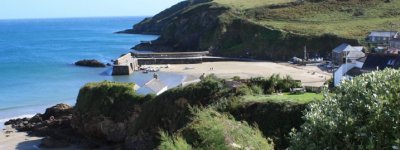


Unspoilt picturesque harbour
Web: www.gorranhaven.org.uk
Web: www.visitcornwall.com/things-to-do/beaches/gorran-haven-beach
Less than three miles separate Mevagissey and Gorran Haven, but the contrast is sharp. Mevagissey is a working harbour, Gorran Haven a small picturesque anchorage, dozing on its sandy beach with just a few remaining local fishermen and their boats, in the lee of the spectacular 400 foot high Dodman Point. Good swimming and snorkelling are its assets with, for sailors, a protective hard. Visit the distinctive landmark of its 15th century church of St. Just with 110 foot tower or simply enjoy the quiet and privacy. The population of the village was 1,260 at the 2011 census.
Gorran Haven was an ancient fishing harbour; its first pier was built in the 15th century. In the 18th and 19th centuries it became a port handling merchandise brought from Fowey by barges and lighters. The pier was re-built in the 1820's and reconstructed again in 1888.
To the south of Gorran Haven is one of the highest land marks along the coast, the Dodman Point, site of an ancient hill fort. Reaching out into the sea and crowned by a huge stone cross, the view of St. Austell and Veryan Bay is truly impressive. The Dodman can be reached via the cliff path or from Lamledra and Penare car parks. Vault Beach situated to the east of the Dodman Point offers a mile of silver sand enabling the visitor to enjoy this remarkable unspoilt beach.
To the west of Gorran Haven visitors will find Caerhays Castle, beach and gardens. Caerhays beach is sheltered with golden sand, beach cafe and ample car parking. The gardens are open to the public and boast a breath taking collection of tropical plants in an idyllic setting.
Gorran Church Town - a mile inland is an unspoilt hamlet, centred around the parish church of St. Goran and is of Norman origin and is well worth visiting.
The Gwineas, also known as The Gwinges, are a set of approximately fifteen rocks, off the coast of the fishing village of Gorran Haven, remarkable for its seals, dolphins, gannets, and cormorants. The Gwineas are believed to have been a hill surrounded by a forest. Over time this became an islet and then, eventually, an isolated rock as it is today. While the visible Gwineas has been the site of several shipwrecks, the Yaw, a submerged rock to the east, has been the cause of more wrecks. In 1895 the mainly steel-built Russian barque 'Pallas' was wrecked on Great Perhaver Beach after grounding on The Gwineas in an easterly gale. The vessel's cargo was timber and all the crew were rescued. A large amount of steel wreckage once survived in the shallows. In 1940, the SS 'Ardangorm', a 5,000-ton vessel, struck the Gwineas in an ESE gale at night when en route from Cardiff to Fowey in ballast.
Within close proximity are The Lost Gardens of Heligan, featured on television and recently restored. Lost for many years under mountains of bramble, ivy, rampant laurel and fallen timber, this was truly a "Sleeping beauty".
Hemmick - Among the excellent variety of beaches in the area, reached by going down winding lanes and with its rock pools and sheltered coves, is ideal for those who prefer more seclusion.
The Cornish author and schoolteacher Anne Treneer (1891-1966) was born at Gorran.
The geologist Charles William Peach (1800-1886) worked in the area and there is a plaque to his memory in the village.
Ben Peach (1842-1926), son of Charles, geologist, was born in the village.
The former head of MI6 Sir Richard Dearlove (1945-) was born and initially raised in Gorran Haven.
Colin Wilson (1931-2013), author, lived in the village during the 1950's
New Year's Day Swim - January.
Gala Day - Early August.
Mevagissey The Coastal Footpath Caerhays Castle Portholland Portmellon
Boswinger Youth Hostel Dodman Point